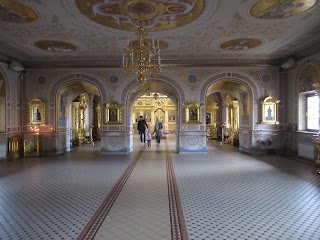The Holy Trinity Cathedral.
The from of the cathedral. It was built to an unusual design for traditional Orthodox churches and a later extension incorporated the belfry into the main body of the church when they were usually kept separate.
The upper summer church.
The Crane Memorial is part military museum, part eternal flame and part memorial. You are greeted at the entrance by a fighter plane and a armoured train.
Complete with anti air craft guns.
And another at the back.
The navy have a space as well with the display of a fast river patrol boat.
Abtiairctraft guns were essential and many different types were made...
...and with multiple barrels.
Stalin's Organ or officially named Katrushka Rocket Launcher.
And several pieces of heavy artillery.
And a selection of APC and tanks......an APC with machine gun...
...a light tank...
...icon T34s...
...of several designs...
...and a heavy self propelled artillery piece.
The eternal flame sits at the base of the flight of steps. The flight has several half landings, one for each year of fighting. And the are cranes mounted near the top of the metal column, since cranes always come back to the same nest.
Each year also has a number of the major battles inscribed in stone.
Then is was a walk around the city central, with a statue to commemorate the 429th birthday of the city with the symbols for which the city is renowned.
One of the very few churches to survive. The main cathedral was less lucky as it had its domes removed and was used as dormitories for students. This small church survived as it was concerted into a planetarium until the 1990's when it was restored and is now once again a church.And the Conservatoire in an unusual style, more like a Bavarian Rathaus than Slavic style.


























No comments:
Post a Comment